| Monster Hunter Freedom Unite: English/Spanish Dedummyfier Patch | |
|---|---|
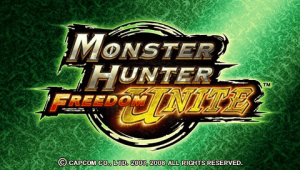 | |
| General | |
| Author | amaillo |
| Type | Translations |
| Version | 1.2 |
| License | Mixed |
| Last Updated | 2022/11/30 |
| Links | |
| Download | |
| Website | |
| Source | |
Monster Hunter Freedom Unite: English/Spanish Dedummyfier patch. As its name indicates, this patch de-dummyfies items, which means it places their respective original names and descriptions but those are totally translated into English (and Spanish).
The program works both on Windows and on any other device with Python 2.7 onwards. Compatible with both USA and EUR games.
Features
- Names and descriptions of all the (62) dummy items in English (and Spanish).
- A patcher program with which anyone can edit the text of the game at will.
- Various fixes to in-game SPANISH text (ex: “¡Se acabó la resistencia al frío!” was changed to “!Se acabó la resistencia al calor!”).
Installation
| Game information | |
|---|---|
| Japanese title | モンスターハンターポータブル 2nd G |
| English title | Monster Hunter Freedom Unite |
| ROM information (EUR) | |
| SHA-1 | B67F57E2EA0D5A31D3C58EB0C7E54C4EF47EA838 |
| CRC32 | 32627BAA |
| ROM information (USA) | |
| SHA-1 | F5CB0EAEBBF5008BD8D486832229AE97A16BBEE6 |
| CRC32 | 7FDED7AD |
Important notes:
- Applying a wrong patch may corrupt the iso, so make sure to backup the ISO first for your own safety. The author is not responsable for how you use this program and what you do with it.
- Applying this patch will remove censorship from the game as it was necessary to remove the blacklist of censored words to free up space and be able to place the content of this patch.
- Check the documentation folder for a complete list of changes.
Patches description:
- patch_dummy_EN.mhfu - English translations for "dummy" items/weapons/armors names and descriptions.
- patch_dummy_ES.mhfu - Spanish translations for "dummy" items/weapons/armors names and descriptions as well as some other changes to fix some errors on the official Capcom translation.
How to apply the patch:
- Copy or move your mhfu iso file inside "iso" folder.
- Make sure the file is not open anywhere else.
- Run "patch.bat" (Windows) or check the "additional infos" section below if you use another OS.
- If there are multiple patch/iso files, you will be asked to select the one to use.
- If everything is OK, you will be asked to type "y" to patch the iso.
- Type y then enter.
- Test the patched iso.
Alternatively: You can download xdelta UI and patch (or unpatch) your iso using the files inside the xdelta folder.
User guide
FAQ
Q. Why does the dummy items exist?
Every item in this collection shares one thing in common: they are all collaborative efforts between Capcom and various Japanese companies. In order to distribute these products beyond Japan, it is necessary for Capcom to obtain an international distribution license from the other companies involved. However, Capcom has chosen not to pursue this path and instead opted to forego the expenses associated with localization, translation, and licensing by discontinuing the distribution of these items.
Another important aspect to consider is whether it is logical to distribute something to an international market that references individuals like a pair of Japanese comedians who lack recognition outside of their home country.
Q. What is Famitsu, Dengeki or JUMP?
They are Japanese magazines. Famitsu is published by Enterbrain Inc. and focuses on video games; Instead, Dengeki's magazines is centered on video games, manga, light novels, and anime. As for JUMP, it is owned by Shueshia, and has several series of magazines with themes that are not very different from those of the previous mentioned magazines.
Q. What is an Amezari?
It is a shortening for America Zarigani (アメリカザリガニ), whose literal translation would be "American Crayfish". America Zarigani is the name used by a duo of Japanese comedians known for doing comedy of the manzai type (the smart/serious/Tsukkomi guy and the silly/funny/Boke guy).
These comedians did a collaborative campaign with Capcom and the sounds and voices of the Amezari weapons come from themselves.
Q. Why use X as the name for the item and not Y?
Without know how the official Capcom translation or adaptation would have been and knowing the origin of the item (a collaboration), it is understandable to think what if the objective of do a collaboration is to advertise, so it is necessary to maintain something that can be recognized by the public, to whom the advertising is directed, so in that way the public can determine what is being advertised.
This is where removing everything related to, for example, Amezari, to change it to something else more understandable to a non-Japanese audience like a red lobster, it goes against the purpose of doing a collaborative campaign (to advertise) because knowledge of what is being advertised is lost.
By the way, the pirate's items originally were going to be like "Pirate J ITEM" but they were changed to "Pirate ITEM J" to be equal to the official names.
Q. Why decided to use your translations of the pirate items descriptions if there are already official translations made by Capcom?
The official translations are very good! But sometimes they were very long, and if they were cut to made it fit on the game then they were not longer be the official ones, right?
In the case of Monster Hunter Generations (MHGen), despite being a newer game compared to Monster Hunter Freedom Unite (MHFU), the original Japanese text, like in MHFU, was simplified and sometimes omitted to make them shorter (presumably due to space limitations per description). While the patch for MHGen also underwent similar simplification, it was usually for obvious details such as "leg equipment" or occasionally for longer and less descriptive terms like "legendary" (complete sentences were rarely removed, but if it was done is because there was simply no more space to develop it in an understandable way). However, the term "pirate" was kept whenever possible (that's why some descriptions say only " of pirate" in the first sentence), all in order to give more space to develop better and more completely the next sentence whose text was generally larger and more interesting.
Thus, you may think that fan-translations used in the patch are more similar to the Japanese text than the official ones, although they still had some content cuts, so we agree that both they are "different" and that's it. Finally, it is necessary to add that the official translations were reviewed when those of the patch had already been made and perfected, there was not much case in using the official ones taking into account what was said above.
TL;DR: to focus more on making more information (of the relevant one) fit, instead of just putting a part of it.
However, if you want to change the descriptions of those items to the official ones (even if you have to cut several of these and then make them not officials), you have all the freedom to do it, these are in the translation masterlist, remember that you can make your own patch following the steps in the text "How to make your own patch".
Q. What is Polytan?
It is the mascot of the Dengeki video game magazine. He is known for using very informal and vulgar language, despite having a cute appearance. Due to the latter, was decided to use those shortenings in his dialogues to give him a certain touch of "this guy talks in a very casual way". Is yellow.
Q. What is a Diasorute?
A subspecies of Diablos that, due to a mutation, is a crimson brown color. It appears in the MHDOS manga By Arai Teruko (Ilustrator of FE: Heroes) that was published by Dengeki Maoh in 2007 and is known as the Demon King Diasorute. The manga was never translated by fans (or at least I couldn't find any project on it), so there is no way to read it in Spanish or English out there.
You can find more information about the article here:
- http://www.capcom.co.jp/monsterhunter/topic_comic.html
- https://www.amazon.co.jp/exec/obidos/ASIN/4840238332/demonblos-22/ref=nosim/
- http://kuroyonhon.com/dic/w/1536.php
- ISBN-10: 4840238332
- ISBN-13: 978-4840238335
Note: it is very curious how in the url of the amazon page they refer to the article as "demonblos".
Q. What does the J stand for on pirate items? Jolly?
J is for JUMP. Maybe is a reference to the pirate JUMP, the mascot of Shonen JUMP magazine. His face when turned 70° looks like a girl.
| ▼ Image | ||
|---|---|---|
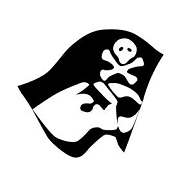 |
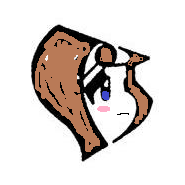 | |
Q. What are "Gavas"?
It is a currency used on the official Famitsu site.
Q. What is a Roger? (in reference to the item called "Pirate Roger J").
We're not sure. But it is likely a reference to either a One Piece character or the Jolly Roger flags (you know, the typical pirate flag) since the hat has a similar flag on its front side.
Q. Whats mean EB? (in reference to the description of the item called: EldrDrgGLance"Emblem")
Probably Enterbrain, the owners of Famitsu.
Q. Why were no many acronyms, acronyms, and shortenings not used in the descriptions? (besides "EB")
Contrary to the names of the objects, their descriptions do not usually have any form of shortening in both English and Spanish, so personally I (amaillo) decided to respect that to make it more like the official translations. "EB" was already like this in the original Japanese text.
By the way, this is very common, if you check some official translations of descriptions you will notice that many of them were simplified or have words or main ideas that were not used in the translated version because they did not fit in the text box. 87 Characters are too few.
Screenshots
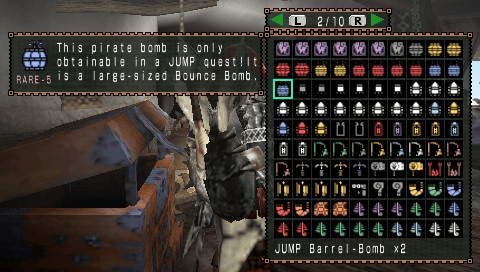

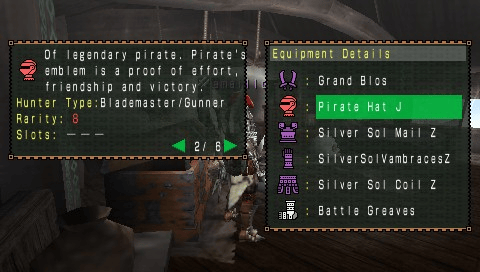
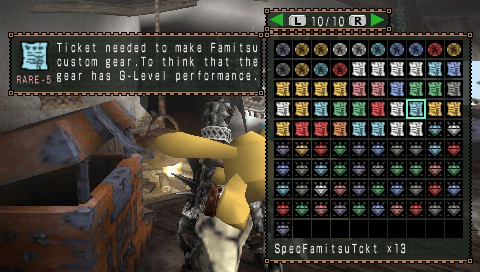
Changelog
v1.2 (Edited by: amaillo)
- Dual Tessen "Gavas" tree description fixed (The english description was in the spanish translation and viceversa)
- Capcom official translations for pirate armor in MHF2 will subtitute the unofficial ones used in the patch previously from now on, I hope no one misses them.
- Notes from the summary were moved to the masterlist.
- Summary and Masterlist were updated with the previous changes.
- FAQ edited (The question about why not include MHGen pirate items official translation was removed due the addition of MHF2 official translations in the patch, i did not know about the existence of those before).
Credits
- Sky_MH - Creator of patchers.
- amaillo - Main JPN-ENG and ENG-ESP translator.
- Kenta - Japanese to english consultant.
- TeamHGG - Translators of MHP2NG english patch.
Thanks to: Codestation, Tywalina, Ruumi, Kenta, Nordal, EclipseKnight, devs of free online translators tools like Google, Yandex, Bing and Japanese-English dictionary's like Mazii, Jisho, Weblio etc, as well as Notepad ++ developer Don Ho and the creator of the plugin to compare text files in Notepad ++, jsleroy.
External links
- Romhacking.net - https://www.romhacking.net/translations/6639/